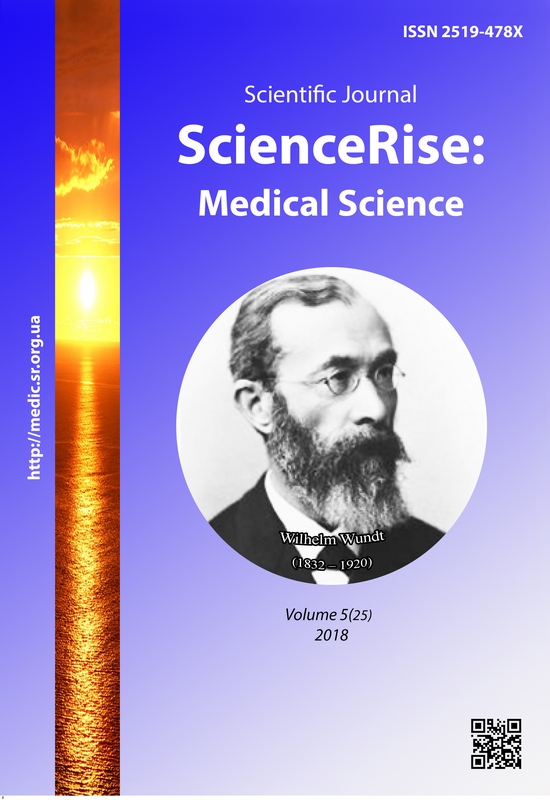Tau-protein content in blood serum in progredient types of multiple sclerosis courses
DOI:
https://doi.org/10.15587/2519-4798.2018.139724Keywords:
tau protein, multiple sclerosis, courses, progressive, relapsing, gender differences, prognosisAbstract
Aim. To identify the quantitative diagnostic indexes of tau protein for prognosis of progressive courses (PC) of multiple sclerosis.
Method. The value of tau protein in blood serum had been detecting within three groups. These groups included 75 patients with different courses of MS course: the 1st group - 30 patients (20 women and 10 men) with secondary progressive course; the 2nd group - 15 patients (6 women and 9 men) with primary progressive course; the 3d group (control group) included 30 patients (24 women and 6 men) with relapsing course of multiple sclerosis.
The index of tau protein was calculated in a laboratory of neurophysiology, immunology and biochemistry of SI “INPN NAMS of Ukraine” by immunofluorescence method.
This method makes it possible to identify the subcellular component by a specific immunological reaction. It has high specificity and sensitivity. We have used the standard kits of “Sigma” production (USA). This method allows both a qualitative visual description of the distribution of optical density of tau protein in each patient and the quantitative determination of tau protein level in the blood serum.
Results. We have conducted the comparative assessment of tau protein value depending on the type of course, the gender differences, the patient’s age at the time of study, the patient’s age at the onset of the disease (clinical onset), the duration of the disease, the severity of neurological deficiency according to the EDSS scale, and also searched for a predictive quantitative diagnostic index.
Studies have shown that the level of tau protein in the blood serum depends on the type of multiple sclerosis’ course and it predominates in progressive course compared to the comparison group of patients with remitting course. The influence of the gender on the value of tau protein in different types of multiple sclerosis was selective and predominant only in women with a primary-progressive course. A complex relationship between the level of tau protein, the age of onset, the duration of disease and the type of multiple sclerosis’ course was determined.
Conclusions.
1. The study shows that tau protein participates in the mechanisms of degenerative process’ formation in progressive courses of multiple sclerosis.
2. We have obtained the data on possible application of this criterion in a complex of prognosis for progressive courses of multiple sclerosis
References
- Benedict, R. H. B., Shucard, J. L., Zivadinov, R., Shucard, D. W. (2008). Neuropsychological Impairment in Systemic Lupus Erythematosus: A Comparison with Multiple Sclerosis. Neuropsychology Review, 18 (2), 149–166. doi: http://doi.org/10.1007/s11065-008-9061-2
- Guimaraes, J., Cardoso, M. J., Sa, M. J. (2006). Tau protein seems not to be a useful routine clinical marker of axonal damage in multiple sclerosis. Multiple Sclerosis Journal, 12 (3), 354–356. doi: http://doi.org/10.1191/1352458506ms1288sr
- Roder, H. M., Hutton, M. L. (2007). Microtubule-associated protein tau as a therapeutic target in neurodegenerative disease. Expert Opinion on Therapeutic Targets, 11 (4), 435–442. doi: http://doi.org/10.1517/14728222.11.4.435
- Geurts, J. J., Barkhof, F. (2008). Grey matter pathology in multiple sclerosis. The Lancet Neurology, 7 (9), 841–851. doi: http://doi.org/10.1016/s1474-4422(08)70191-1
- Voloshyn-Gaponov, I. K. (2010). Features of tau protein value in blood of patients with multiple sclerosis. Ukrayinskii medichnii chasopis, 2 (76), 106–108.
- Voloshyn-Gaponov, I. K., Vasylovskyy, V. V., Lekomtzeva, Ye. V. (2013). Thermal tau as a new biomarker for psycho-axonal brain injury in patients with multiple sclerosis. Visnyk Kharkivskoho natsionalnoho universytetu, 1065, 172–174.
- Voloshyn-Gaponov, I. K., Voloshyna, N. P., Yegorkina, О. V., Lekomtzeva, Ye. V. (2009). Thermal tau protein as a marker for axonal brain injury. Ukrainskyi visnyk psykhonevrolohii, 17 (4 (61)), 4–5.
- Zemian, P. F. (2003). Pat. US No. 6589746. Method of detecting axonally – derived protein tau in patients with traumatic CNS injury. No. 09/694627; declareted: 23.10.2000; published: 08.07.2003.
- Voloshyna, N. P., Vasylovskyy, V. V., Negreba, T. V., Levchenko, I. L., Tkacheva Т. N. (2013). Clinical description of multiple sclerosis onsets in different courses, considering the current prognosis. Ukrainskyi nevrolohichnyi zhurnal, 4 (29), 7–13.
- Voloshyna, N. P., Vasylovskyy, V. V., Negreba, T. V. et. al. (2013). New approaches to clinical diagnostics of various courses of multiple sclerosis and their differentiated therapy. Practical recommendations Copyright certificate No. 47786 dated 13th February 2013.
Downloads
Published
How to Cite
Issue
Section
License
Copyright (c) 2018 Vitaliy Vasylovskyy

This work is licensed under a Creative Commons Attribution 4.0 International License.
Our journal abides by the Creative Commons CC BY copyright rights and permissions for open access journals.
Authors, who are published in this journal, agree to the following conditions:
1. The authors reserve the right to authorship of the work and pass the first publication right of this work to the journal under the terms of a Creative Commons CC BY, which allows others to freely distribute the published research with the obligatory reference to the authors of the original work and the first publication of the work in this journal.
2. The authors have the right to conclude separate supplement agreements that relate to non-exclusive work distribution in the form in which it has been published by the journal (for example, to upload the work to the online storage of the journal or publish it as part of a monograph), provided that the reference to the first publication of the work in this journal is included.









